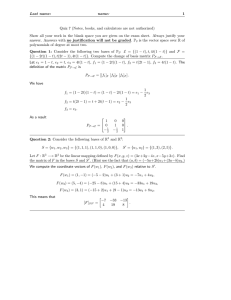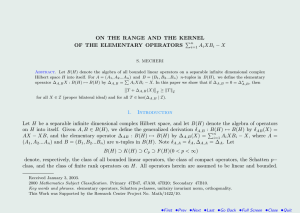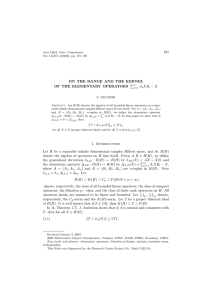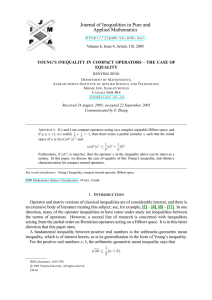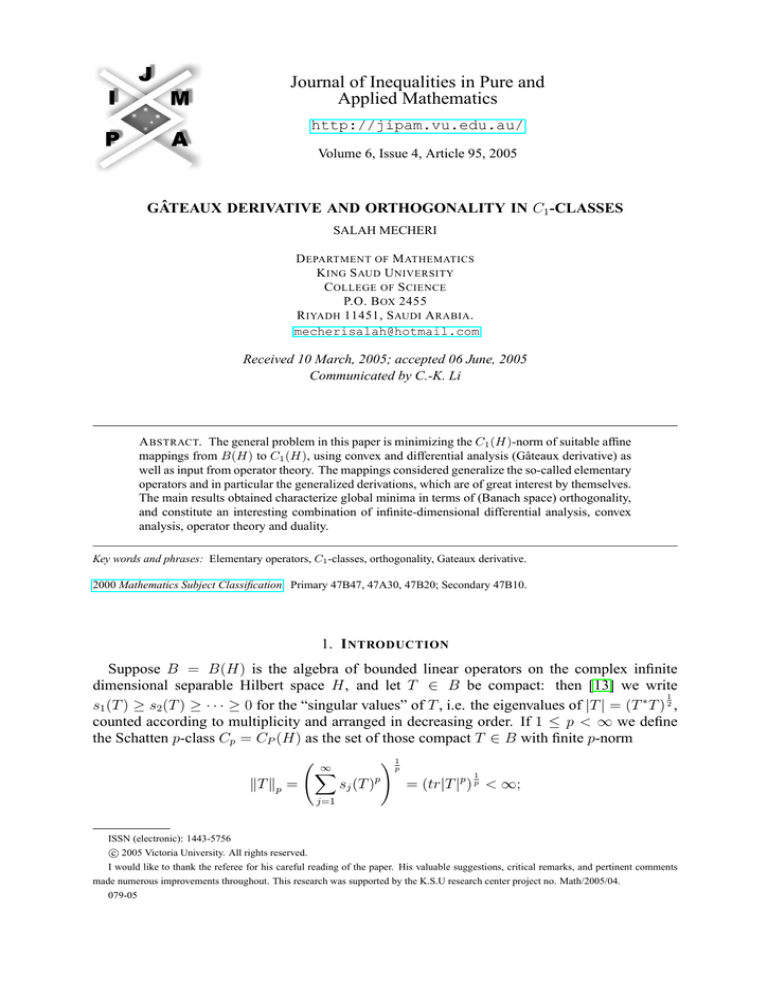
Journal of Inequalities in Pure and
Applied Mathematics
http://jipam.vu.edu.au/
Volume 6, Issue 4, Article 95, 2005
GÂTEAUX DERIVATIVE AND ORTHOGONALITY IN C1 -CLASSES
SALAH MECHERI
D EPARTMENT OF M ATHEMATICS
K ING S AUD U NIVERSITY
C OLLEGE OF S CIENCE
P.O. B OX 2455
R IYADH 11451, S AUDI A RABIA .
mecherisalah@hotmail.com
Received 10 March, 2005; accepted 06 June, 2005
Communicated by C.-K. Li
A BSTRACT. The general problem in this paper is minimizing the C1 (H)-norm of suitable affine
mappings from B(H) to C1 (H), using convex and differential analysis (Gâteaux derivative) as
well as input from operator theory. The mappings considered generalize the so-called elementary
operators and in particular the generalized derivations, which are of great interest by themselves.
The main results obtained characterize global minima in terms of (Banach space) orthogonality,
and constitute an interesting combination of infinite-dimensional differential analysis, convex
analysis, operator theory and duality.
Key words and phrases: Elementary operators, C1 -classes, orthogonality, Gateaux derivative.
2000 Mathematics Subject Classification. Primary 47B47, 47A30, 47B20; Secondary 47B10.
1. I NTRODUCTION
Suppose B = B(H) is the algebra of bounded linear operators on the complex infinite
dimensional separable Hilbert space H, and let T ∈ B be compact: then [13] we write
1
s1 (T ) ≥ s2 (T ) ≥ · · · ≥ 0 for the “singular values” of T , i.e. the eigenvalues of |T | = (T ∗ T ) 2 ,
counted according to multiplicity and arranged in decreasing order. If 1 ≤ p < ∞ we define
the Schatten p-class Cp = CP (H) as the set of those compact T ∈ B with finite p-norm
kT kp =
∞
X
! p1
sj (T )p
1
= (tr|T |p ) p < ∞;
j=1
ISSN (electronic): 1443-5756
c 2005 Victoria University. All rights reserved.
I would like to thank the referee for his careful reading of the paper. His valuable suggestions, critical remarks, and pertinent comments
made numerous improvements throughout. This research was supported by the K.S.U research center project no. Math/2005/04.
079-05
2
S. M ECHERI
here tr denotes the trace functional. Thus C1 = C1 (H) is the trace class, C2 = C2 (H) is the
Hilbert-Schmidt class. We write C∞ = C∞ (H) for the compact operators, with
kT k∞ = s1 (T ) = sup kT f k
kf k=1
the usual operator norm of T .
If V is a Banach space then a mapping f : V → C is said to be “Gateâux differentiable” at a
point a ∈ V if the limit
1
lim+ (f (a + tx) − f (a))
t→0 t
exists for each point x ∈ V . If this applies to the norm f = k·k, then a ∈ V is said to be a
smooth point, and the functional da f = Re(Da ) is [13] sublinear, with
kDa k = 1;
Da = kak = −Da (−a).
For elements a, b of a Banach space V , we say that b is orthogonal to a, written b ⊥ a,
provided
kak = dist(a, Cb),
such that the line a + Cb is tangential to the ball of center 0 and radius kak; when V = H is
a Hilbert space this agrees with the usual inner product ha; bi = 0. Thus when b ⊥ a then the
expression ka + λbk has a global minimum when λ = 0 ∈ C.
In this paper we show how such a global minimum can be detected by the sign of the Gateâux
derivative, and apply it to range-kernel orthogonality for certain kinds of elementary operators.
2. G LOBAL M INIMA
Our main result characterises certain kinds of global minima in terms of the Gateâux derivative of a norm:
Theorem 2.1. If ϕ : V → V is linear and a ∈ V then the mapping
(2.1)
x 7→ ka + ϕ(x)k
(V → R)
has a global minimum at b ∈ V if and only if
(2.2)
∀x ∈ V,
Da+ϕ(b) (x) ≥ 0.
Proof. Necessity follows from the linearity of ϕ. Conversely with L = Da+ϕ(b) ,
ka + ϕ(b)k = −L(−a − ϕ(b)) + L(ϕ(x) − ϕ(b)) ≤ L(a + ϕ(x)) ≤ ka + ϕ(x)k .
It is well known that this holds for all a ∈ V = Cp (H), since [7] Cp is always uniformly
convex; specifically, with a = u|a| the polar decomposition
p−1
∗
Da (x) = kak−(p−1)
tr
|a|
ux
, x ∈ Cp .
p
This fails when either p = 1 or p = ∞. The norm [2] Gateâux differentiable at 0 6= a ∈ C1 (H)
if and only if either a or a∗ is injective, with for a = u|a|
Da (x) = Re tr(u∗ x)
if a one one,
Da (x) = Re tr(ux) if a∗ one one.
We now offer a characterization of the global minimum of a map x 7→ kaϕ (x)k derived from a
linear map ϕ : C1 → C1 which is adjointable in the sense that there exists ϕ∗ : C1 → C1 for
which
∀x, y ∈ C1 , tr(xϕ(y)) = tr(ϕ∗ (x)y).
J. Inequal. Pure and Appl. Math., 6(4) Art. 95, 2005
http://jipam.vu.edu.au/
G ÂTEAUX D ERIVATIVE AND O RTHOGONALITY IN C1 - CLASSES
3
This is certainly the case for the elementary operators Ea,b = La ◦ Rb induced by a, b ∈ B n :
∗
Ea,b
= Ea∗ ,b∗ .
Theorem 2.2. A necessary and sufficient condition for ka + ϕ(x)k to have a global minimum
at a smooth point b ∈ C1 (H), with polar decomposition a + ϕ(b) = u|a + ϕ(b)|, is that
u∗ ∈ ker(ϕ∗ ).
Proof. Assume that ka + ϕ(x)k has a global minimum on C1 at b. Then
Da+ϕ(b) (ϕ(x)) ≥ 0
(2.3)
for all x ∈ C1 . That is,
Re {tr(u∗ ϕ(x))} ≥ 0, ∀x ∈ C1 .
Let f ⊗ g, be the rank one operator defined by v 7→ hv, f i g, where f, g are arbitrary vectors in
the Hilbert space H. Take x = f ⊗ g, since the map ϕ satisfies (2.2) one has
tr(u∗ ϕ(x)) = tr(ϕ∗ (u∗ )x).
Then (2.3) is equivalent to Re{tr(φ∗ (u∗ )x)} ≥ 0, for all x ∈ C1 , or equivalently
Re hϕ∗ (u∗ )g, f i ≥ 0,
∀f, g ∈ H.
If we choose f = g such that kf k = 1, we get
Re hϕ∗ (u∗ )f, f i ≥ 0.
(2.4)
Note that the set
{hϕ∗ (u∗ )f, f i : kf k = 1}
is the numerical range of φ∗ (u∗ ) on U which is a convex set and its closure is a closed convex
set. By (2.4) it must contain one value of positive real part, under all rotation around the origin,
it must contain the origin, and we get a vector f ∈ H such that hϕ∗ (u∗ )f, f i < , where is
positive. Since is arbitrary, we get hϕ∗ (u∗ )f, f i = 0. Thus ϕ∗ (u∗ ) = 0, i.e., u∗ ∈ ker ϕ∗ .
Conversely, if u∗ ∈ ker ϕ∗ , it is easily seen (using the same arguments above) that
Re {tr(u∗ φ(x))} ≥ 0,
∀x ∈ C1 .
By this we get (2.3).
3. R ANGE -K ERNEL O RTHOGONALITY
Anderson [1] showed that for normal operators a ∈ V = B = B(H) on a Hilbert space H
then
ax = xa ⇒ kx + ay − yak ≥ kxk :
the range of the derivation δa : y 7→ ay − ya is orthogonal to its kernel. This result has been
generalized [4, 12, 14] to more general elementary operators
n
X
Ea,b ≡ La ◦ Rb :7→
aj xbj
j=1
both on V = B(H) and on the Schatten ideals V = Cp (H). The Gateâux derivative was used
in [6], [5], [7], [8] and [10].
We state our first corollary of Theorem 2.2. Let ϕ = δa,b , where δa,b : B(H) → B(H) is the
generalized derivation defined by δa,b (x) = ax − xb.
Corollary 3.1. Let s be a smooth point in C1 , and let s + ϕ(s) have the polar decomposition
s + ϕ(s) = u |s + ϕ(s)|. Then ks + ϕ(x)kC1 has a global minimum on C1 at s, if and only if,
u∗ ∈ ker δb,a .
J. Inequal. Pure and Appl. Math., 6(4) Art. 95, 2005
http://jipam.vu.edu.au/
4
S. M ECHERI
Proof. It is a direct consequence of Theorem 2.2.
This result may be reformulated in the following form where the global minimum s does
not appear. It characterizes the smooth point s in C1 which is orthogonal to the range of the
generalized derivation δa,b .
Theorem 3.2. Let s be a smooth point in C1 , and let s + ϕ(s) have the polar decomposition
s + ϕ(s) = u |s + ϕ(s)|. Then
ks + ϕ(x)kC1 ≥ ks + ϕ(s)kC1 ,
for all x ∈ C1 if and only if u∗ ∈ ker δb,a .
As a corollary of this theorem we have
Corollary 3.3. Let s ∈ C1 ∩ ker δa,b , and let s + ϕ(s) have the polar decomposition s + ϕ(s) =
u |s + ϕ(s)|. Then the two following assertions are equivalent:
(1) ks + (ax − xb)kC1 ≥ kskC1 , for all x ∈ C1 .
(2) u∗ ∈ ker δb,a .
Remark 3.4. We point out that, thanks to our general results given previously with more general
linear maps ϕ, Theorem 3.2 and its Corollary 3.3 are true for the nuclear operator ∆a,b (x) =
axb − x and other more general classes of operators than δa,b like the elementary operators Ea,b .
Now by using Theorem 3.2, Corollary 3.3, Remark 3.4 we obtain some interesting results see
also ([14]).
Let s = u |s| be the polar decomposition of s, where s is a smooth point in C1 and let
Ẽa,b = Ea,b − I.
P
Theorem 3.5. Let c = (c1 , c2 , . . . , cn ) be an n−tuple of operators in B(H) such that ni=1 ci c∗i ≤
P
1, ni=1 c∗i ci ≤ 1 and ker Ẽc ⊆ ker Ẽc∗ . Then s ∈ ker Ẽc ∩ C1 , if and only if,
(3.1)
s + Ẽc (x) ≥ ksk1
1
for all x ∈ C1 .
Proof. Let s be in ker Ẽc |C1 . Then it follows from Corollary 3.3 applied for the elementary
operator Ẽc that
s + Ẽc (x) ≥ ksk1
1
∗
for all x ∈ C1 if and only if u ∈ ker Ẽc . The hypothesis ker Ẽc ⊆ ker Ẽc∗ , implies that
u∗ ∈ ker Ẽc∗ . Note that u∗ ∈ ker Ẽc ⊆ ker Ẽc∗ if and only if
(3.2)
tr(u∗ Ẽc (x)) = 0 = tr(u∗ Ẽc∗ (x)).
Choosing x ∈ C1 to be the rank one operator f ⊗ g it follows from (3.2) that if (3.1) holds then
!
!
n
X
= tr
ci u∗ ci − u∗ (f ⊗ g)
i=1
=
n
X
!
ci u∗ ci g, f
− (u∗ g, f ) = 0
i=1
and
n
X
!
c∗i u∗ c∗i g, f
− (u∗ f, g) = 0
i=1
J. Inequal. Pure and Appl. Math., 6(4) Art. 95, 2005
http://jipam.vu.edu.au/
G ÂTEAUX D ERIVATIVE AND O RTHOGONALITY IN C1 - CLASSES
5
for all f, g ∈ H or
Ẽc (u) = 0 = Ẽc∗ (u).
Pn ∗
It is known that if
≤ 1, i=1 ci ci ≤ 1 and Ẽc (s) = 0 = Ẽc∗ (s), then the eigenspaces
corresponding to distinct non-zero eigenvalues of the compact positive operator |s|2 reduce each
ci see ([4, Theorem 8]) and ([14, Lemma 2.3]). In particular |s| commutes with each ci for all
1 ≤ i ≤ n. Hence (3.1) holds if and only if,
Pn
∗
i=1 ci ci
Ẽc (s) = 0 = Ẽc∗ (s).
Theorem 3.6. Let a = (a1 , a2 , . . . , an ), b = (b1 , b2 , . . . , bn ) be n−tuples of operators in B(H)
such that
n
n
n
n
X
X
X
X
ai a∗i ≤ 1,
a∗i ai ≤ 1,
bi b∗i ≤ 1,
b∗i bi ≤ 1
i=1
i=1
i=1
i=1
and ker Ẽa,b ⊆ ker Ẽa∗ ,b∗ .
Then s ∈ ker Ẽa,b ∩ C1 , if and only if,
s + Ẽa,b (x) ≥ ksk1
1
for all x ∈ C1 .
Proof. It suffices to take the Hilbert space H ⊕ H, and operators
ai 0
0 t
0 x
ci =
, s=
, x=
0 bi
0 0
0 0
and apply Theorem 3.5.
R EFERENCES
[1] J. ANDERSON, On normal derivations, Proc. Amer. Math. Soc., 38(1) (1979), 129–135.
[2] T.J. ABATZOGLOU, Norm derivatives on spaces of operators, Math. Ann., 239 (1979), 129–135
[3] G. BIRKHOFF, Orthogonality in linear metric spaces, Duke Math. J., 1 (1935), 169–172.
[4] R.G. DOUGLAS, On the operator S ∗ XT = X and related topics, Acta. Sci. Math. (Szeged), 30
(1969), 19–32.
[5] D. KECKIC, Orthogonality of the range and the kernel of some elementary operators, Proc. Amer.
Math. Soc., 128(11) (2000), 3369–3377.
[6] F. KITTANEH, Operators that are orthogonal to the range of a derivation, J. Math. Anal. Appl., 203
(1996), 863–873.
[7] P.J. MAHER, Commutator Approximants, Proc. Amer. Math. Soc., 115 (1992), 995–1000.
[8] S. MECHERI, On minimizing kS − (AX − XB)kp , Serdica Math. J., 26(2) (2000), 119–126.
[9] S. MECHERI, On the orthogonality in von Neumann-Schatten classes, Int. Jour. Appl. Math, 8
(2002), 441–447.
[10] S. MECHERI, Another version of Maher’s inequality, Z. Anal. Anwen, 23(2) (2004), 303–311
[11] S. MECHERI, Non normal derivations and orthogonality, Proc. Amer. Math. Soc., 133(3) (2005),
759–762.
P
[12] S. MECHERI, On the range and the kernel of the elementary operatores
Ai XBi − X, Acta
Math. Univ. Comenianae, LXXII(2) (2003), 191–196.
J. Inequal. Pure and Appl. Math., 6(4) Art. 95, 2005
http://jipam.vu.edu.au/
6
S. M ECHERI
[13] B. SIMON, Trace Ideals and their Applications, London Mathematical Society Lecture Notes Series 35, Cambridge University Press, 1979.
[14] A. TURNSEK, Orthogonality in Cp classes, Monatsh. Math., 132(4) (2001), 349–354.
J. Inequal. Pure and Appl. Math., 6(4) Art. 95, 2005
http://jipam.vu.edu.au/


